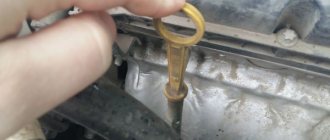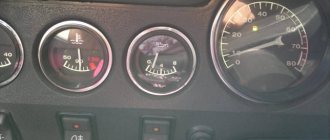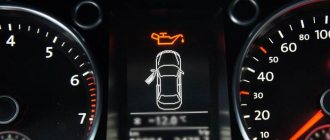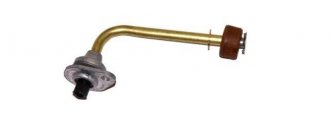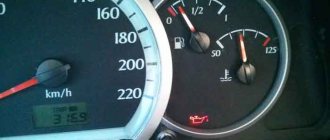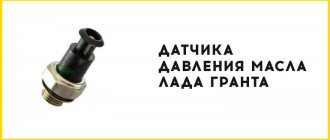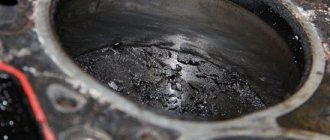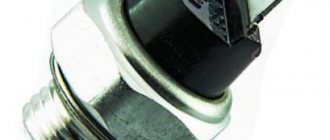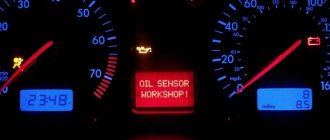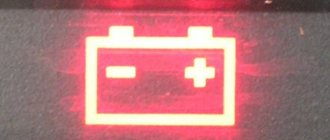Dashboard with oil pressure light on
There are cases when on the dashboard of a car, immediately after starting the engine, as well as at idle speed, the oil pressure warning light on a VAZ 2110 suddenly lights up. At the same time, it is unlikely to be possible to find out the reason without opening the hood; moreover, there are several reasons for this If the oil pressure light on the VAZ 2110 comes on, you can be sure of only one thing - something has already failed in the engine of your car or is just beginning to fail.
The purpose of the light bulb and why it lights up
In our article, I will try to tell you in detail about all the possible reasons why such an unpleasant phenomenon occurs, such as the oil pressure light on a VAZ 2110, as well as ways to determine the cause and methods for eliminating detected faults. So:
- The oil pressure warning light on the dashboard is an indicator that warns or, in extreme cases, confirms that something is wrong with the engine
- The list of possible reasons when the oil pressure light comes on on a VAZ 2110 may include the following: a problem in the operation of the engine, poorly performed repairs to the power unit, or a possible lack of regular, timely and necessary maintenance of the machine
- Whatever the discovered reason, it does not play a special role and the fact that you find out who is to blame for this malfunction will not bring you relief, and the cost of repairs will not decrease from this
- It is very important here to understand that you have a problem and you need to solve it urgently
- The main thing for you now is to detect the malfunction itself, due to which the oil pressure lamp on the VAZ 2110 lights up
- And taking actions to eliminate it as soon as possible, if you do not attach importance to this, the consequences can become much more complex and more global
- I present to your attention the main and common reasons why the oil pressure lamp on the VAZ 2110 indicates a malfunction
The engine oil level is too low
In a VAZ 2110 the oil light came on due to a low level of lubricant in the pan; this reason is the most common:
- Regular operation of the machine requires constant monitoring of the oil level in the engine, and the complete absence of any leaks on the motor housing
- Any oil stains, even seemingly insignificant ones, where your car is permanently parked should already attract your attention and cause alarm.
- By the way, you should not forget the fact that reducing the oil level is also possible on a car that is in quite good condition
Problems due to the filter
So:
- The second possible reason why the VAZ 2110 oil level warning lamp may light up is the use of low-quality or non-original oil filters
- Few people know that after the engine stops and the lubricant drains into the pan, a certain amount of it must remain in the oil filter housing
- This is necessary in order not to create the so-called “oil starvation” effect for the engine.
- However, all low-quality oil filters have exactly this unpleasant and very dangerous feature, since they omit the function of retaining oil inside the filter housing itself.
- Therefore, it flows freely into the sump and when the engine starts, the first revolutions of the parts turn out dry, with increased wear; such a malfunction can also be indicated by the light bulb in the first photo
VAZ branded oil filter
Problems with the bypass (reducing) valve and oil pump
The oil pressure light also starts to glow after the oil bypass (reducing) valve breaks:
- When the system oil pressure is low, then a serviceable bypass valve should be in the closed position
- If the valve is stuck or stuck in the open position, then the required pressure can no longer be created in the system, and as a result, the light on the dashboard comes on
When the oil pump mesh is severely clogged, then the sensor will also signal low pressure in the system:
- With the help of this oil intake mesh, the lubrication pump and the motor itself are protected from large particles getting into it
- Metal shavings and dirt, as well as other foreign elements on the surfaces of parts act as a coarse abrasive material
- When the oil is new, without foreign contaminants, then it passes freely through the mesh; the pressure sensor signals normal pressure inside the system; it is simply “silent”
- However, when the oil becomes contaminated, it does not flow well through the mesh and the system no longer suffers from insufficient pressure necessary for stable operation
- After the lubricant warms up, liquefaction occurs, and the oil seeps through the mesh much easier
- This type of problem can only be identified by removing the pan from the engine.
- Another similar malfunction associated with removing the pan is a breakdown of the oil pump
- A broken pump does not create the required pressure in the system and therefore needs to be replaced
- Which is immediately indicated by the lighting of the lamp for insufficient pressure in the system
Pressure sensor problems
A possible reason could be the sensor that monitors the oil pressure in the lubrication system:
- A faulty wiring of the oil pressure sensor (controller) can also cause the oil pressure light to come on.
- The oil pressure light is an indicator light, it is located on the dashboard, its glow directly depends on the sensor that controls the oil pressure, and lights up when the sensor indicates that there is a problem with the pressure
- One wire connects the lamp and sensor
- In the event that the lubricant pressure drops below the permissible norm, then the sensor is triggered and closes the light bulb to ground.
- As soon as the pressure normalizes or rises even above the set level, the contacts at the sensor open and the lamp goes out.
- However, if there is a malfunction of the sensor itself, the light may not go out, or will only light up when there is a dramatic change in pressure, for example during gas overload
Injection oil pressure sensor
This is interesting: Car polishing equipment - machine and other tools
content .. 35 36 37 38 ..Lada VAZ-2110 (2111, 2112). Insufficient oil pressure (low oil pressure indicator light is on)
| Add oil | ||
| Oil filter is faulty | Replace the filter with a known good one. | Replace the faulty oil filter |
| The bolt securing the auxiliary drive pulley is loose | Check bolt tightness | Tighten the bolt to the specified torque |
| Clogged oil receiver mesh | Inspection | Clear the mesh |
| Skewed, clogged oil pump pressure relief valve or weakened valve spring | Inspection when disassembling the oil pump | Clean or replace the faulty relief valve. Replace the pump |
| Worn oil pump gears | Determined by measuring parts after disassembling the oil pump (at a service station) | Replace the oil pump |
| Excessive clearance between bearing shells and crankshaft journals | Determined by measuring parts after disassembling the oil pump (at a service station) | Replace worn liners. If necessary, replace or repair the crankshaft |
| Insufficient oil pressure sensor is faulty | We unscrew the low oil pressure sensor from the hole in the cylinder head and install a known-good sensor in its place. If the warning light goes out while the engine is running, the inverted sensor is faulty | Replace the faulty low oil pressure sensor |
Causes of drop in oil pressure
There is a light on the instrument panel that indicates emergency oil pressure in the engine. When it lights up, it is a clear sign of a problem. We'll tell you what to do if the oil pressure light comes on and how to fix the problem.
The oil check light can come on for two different reasons: either low oil pressure or low oil level. But what exactly does the oil light on the dashboard mean, only the operating instructions will help you find out. It will help us that, as a rule, budget cars do not have a low oil level indicator, but only a low oil pressure indicator.
Insufficient oil pressure
If the oil light comes on, this means insufficient oil pressure in the engine. As a rule, it lights up only for a few seconds and does not pose a great threat to the engine. For example, it can light up when the car rolls heavily during a turn or during a cold start in winter.
If the low oil pressure light comes on due to a low oil level, then this level, as a rule, is already critically low. First of all, when the oil pressure light comes on, check for the presence of engine oil. If the oil level is below normal, then this is the reason for this lamp to light up. This problem can be solved simply - you need to add oil to the required level. If the light goes out, we rejoice, and do not forget to add oil on time, otherwise this could result in serious problems.
If the oil pressure light is on, but the oil level on the dipstick is fine, then another reason why the indicator could light up is a failed oil pump. It does not do its job of ensuring sufficient oil circulation in the engine lubrication system.
In any case, if the oil pressure or low oil level light comes on, the car must be stopped immediately by pulling to the side of the road or to a safer place and turning off. Why do you need to stop right away? Because if the oil in the engine has depleted significantly, then the engine may stop and break down, with the prospect of very expensive repairs. Don't forget that oil is very important to keep your engine running. Without oil, the engine will fail very quickly - sometimes in just a few minutes of operation.
This situation also occurs when the engine oil is changed to new one. After the first start, the oil pressure light may come on. If the oil is of good quality, it should go out within 10-20 seconds. If it does not go out, the reason is a defective or non-functioning oil filter. It needs to be replaced with a new quality one.
Oil pressure sensor malfunction
The oil pressure at idle speed (at approximately 800 - 900 rpm) should not be less than 0.5 kgf/cm2. Sensors for measuring emergency oil pressure come with different response ranges: from 0.4 to 0.8 kgf/cm2. If a car is equipped with a sensor with a response value of 0.7 kgf/cm2, then even at 0.6 kgf/cm2 it will turn on a warning lamp, signaling a kind of emergency oil pressure in the engine. To understand whether the oil pressure sensor is to blame for the light coming on or not, you need to increase the crankshaft speed to 1000 rpm at idle. If the light goes out, then the oil pressure in the engine is normal. If not, then you need to contact specialists who will measure the oil pressure with a pressure gauge, connecting it instead of the sensor. Cleaning the sensor helps prevent false alarms. You need to unscrew it and thoroughly clean all the oil channels, because the cause of false alarms of the sensor may be due to blockages.
If the oil level is normal and the sensor is working
First of all, you need to check the oil dipstick and make sure that the oil level has not increased since the last check? Does the dipstick smell like gasoline? It is possible that gasoline or antifreeze is getting into the engine. It’s easy to check the presence of gasoline in the oil; you need to dip the dipstick in water and see if gasoline stains remain. If yes, then you need to contact a car service; the engine may need to be repaired. If there is a malfunction in the engine, which is caused by the oil pressure light coming on, it is easy to notice. Engine malfunctions are accompanied by loss of power, increased fuel consumption, and black or blue smoke coming out of the exhaust pipe. If the oil level is normal, then there is no need to worry about a prolonged indication of low oil pressure, for example during a cold start. In winter, at low temperatures, this is an absolutely normal effect. After parking overnight, the oil drains from all lines and thickens. The pump needs a certain time to fill the lines and create the necessary pressure. Oil reaches the main and connecting rod journals earlier than the pressure sensor, so wear of engine parts is eliminated. If the oil pressure light does not go out for about 3 seconds, it is not dangerous.
What you can do yourself
Measuring engine oil pressure The problem of low oil pressure is greatly complicated by the relationship between lubricant consumption and level drop with the overall pressure in the system. In this case, a number of malfunctions can be eliminated independently.
If leaks are detected, the problem is quite easy to localize and solve. For example, oil leakage from under the oil filter can be eliminated by tightening or replacing it. The problem with the oil pressure sensor, through which lubricant flows, is solved in a similar way. The sensor is tightened or simply replaced with a new one. As for seal leaks, in this case you will need time, tools and skills. In this case, you can replace the front or rear crankshaft oil seal with your own hands in your garage with an inspection hole.
Oil leaks from under the valve cover or in the pan area can be eliminated by tightening fasteners, replacing rubber gaskets, and using special engine sealants. Violation of the geometry of the connecting planes or damage to the valve cover/pan will indicate the need to replace such parts.
If the coolant gets into the engine oil, then you can remove the cylinder head yourself and replace the head gasket, while following all the recommendations regarding the removal and subsequent re-covering of the cylinder head. An additional check of the mating planes will indicate whether the cylinder head needs to be ground. If cracks are found in the cylinder block or head, repairs are also possible. As for the oil pump, if this element wears out, it is better to immediately replace it with a new one. It is also not recommended to clean the oil receiver, that is, the part is completely changed. In the case where the problem in the lubrication system is not so obvious, and you have to repair the car yourself, then at the very beginning you should measure the oil pressure in the engine. To solve the problem, as well as taking into account an accurate understanding of where the oil pressure in the engine is measured and how it is done, additional equipment must be prepared in advance. Note that there is a ready-made device for measuring engine oil pressure available for free sale.
As an option, a universal oil pressure gauge will “Measure”. This device is quite affordable and comes with everything you need. You can also make a similar device with your own hands. To do this, you will need a suitable oil-resistant hose, pressure gauge and adapters.
To measure, a ready-made or home-made device is connected instead of an oil pressure sensor, after which the pressure readings on the pressure gauge are assessed. Please note that ordinary hoses cannot be used for self-production. The fact is that oil quickly corrodes rubber, after which the detached parts can get into the oil system.
Results
The pressure in the lubrication system can drop for many reasons: - quality of the oil or loss of its properties; - leaks of oil seals, gaskets, seals; -oil “presses” out of the engine (pressure increases due to malfunctions of the crankcase ventilation system); - oil pump malfunctions, other breakdowns; -the power unit may be severely worn out, etc.
In some cases, drivers resort to using an additive to increase engine oil pressure. For example, XADO revitalizant. According to manufacturers, such an anti-smoke additive with revitalizant reduces oil consumption, allows the lubricant to maintain the required viscosity when heated to high temperatures, restores damaged crankshaft journals and liners, etc.
As practice shows, additives cannot be considered an effective solution to the problem of low pressure, but as a temporary measure for old worn-out engines, this method may be suitable. I would also like to draw your attention to the fact that the blinking oil pressure light does not always indicate problems with the internal combustion engine and its systems. It's rare, but it does happen that electrical problems arise. For this reason, the possibility of damage to electrical components, contacts, pressure sensor or the wiring itself should not be ruled out.
Finally, we would like to add that using only the recommended oil helps to avoid many problems with the oil system and engine. It is also necessary to select a lubricant taking into account individual operating conditions. The correct selection of viscosity index for the season (summer or winter oil) deserves no less attention.
Engine oil and filters must be changed correctly and done strictly according to regulations, since an increase in the service interval leads to severe contamination of the lubrication system. In this case, decomposition products and other deposits actively settle on the surfaces of parts and channel walls, clogging filters and the oil receiver mesh. Under such conditions, the oil pump may not provide the required pressure, causing oil starvation and significantly increasing engine wear.
content .. 35 36 37 38 ..
How does the oil sensor work and why can it fail?
Now let's consider the situation if you are on the road and the low pressure indicator has triggered.
The very first thing you need to do is stop the vehicle and turn off the engine. As soon as it cools down, you will have to check the lubricant level in the system. There is a special dipstick under the hood for this purpose. It is wiped dry and immersed in its original place. It is quite possible that the level will be below the minimum level. This means that somewhere there is a leak or depressurization of connections. You can set off again only after adding oil to the engine. If the lamp continues to light after starting and does not go out subsequently, it makes sense to think about towing the car to the nearest service station or to a trusted auto mechanic. The matter may turn out to be quite serious, so it is advisable to conduct the examination in a calm environment. Since we have already said that the causes of low pressure may be associated with a faulty sensor, it would be useful to understand the principle of operation of this device. There are certain contacts inside it. Until the ignition is turned on, there is no pressure in the system, so the contacts are closed. When you turn the key and turn on the ignition, but before the starter starts, the warning lamp should be on. If this does not happen, then there may be some kind of malfunction. Maybe the light bulb itself simply burned out, or maybe the contacts were broken or the sensor itself failed. As soon as we start the engine, the contacts open, leading to the light bulb going out.
The main reasons for the oil pressure warning light to come on
So, the warning light usually lights up after starting the engine or when it is idling. There may be several reasons for this phenomenon, but the main thing is to understand and accept for yourself that this should be a signal that there is some kind of malfunction. Therefore, you need to take appropriate measures so as not to worsen the situation. In any case, if the lamp blinks, it means that you need to identify the malfunction and do everything to eliminate it as soon as possible.
Among the main reasons for the indicator to light up are the following:
- Reduced lubricant pressure in the system. This is one of the most common reasons, but even today there are owners who stubbornly do not notice signs of oil leakage or do not look into the engine compartment. Why does pressure drop, you ask? Because the oil gradually leaves the system. Therefore, you should pay attention to any stains on the engine or under the car where it is parked. Do not forget that by simply adding lubricant to the system, you do not solve the problem, but only forget about it for a while.
- Another reason for the warning light to blink is due to the use of low-quality oil filters. Some of the lubricant remains in them even when you stop the engine. If the filter is of dubious quality, then it does not retain oil, but it directly flows into the crankcase. Thus, a periodic drop in pressure occurs.
Lack of lubrication may be associated with failure of the pressure relief valve. It should be in the closed position if the pressure level in the system is insufficient. However, when the valve fails or gets stuck, the pressure generated is not enough, which causes the warning light to light up.- Another reason is a faulty pressure sensor. It is directly related to the operation of the control indicator, since it is connected to it by the same wire. As soon as the pressure returns to normal, the contacts should open, as a result of which the indicator should go out. This will not happen if the sensor itself has become faulty.
- The indicator also starts blinking if the oil pump screen is clogged. It acts as an obstacle to particles of dirt, metal, dust and any other unwanted elements that lead to wear on the pump. If the oil is not dirty, but of normal quality, then it freely penetrates through the mesh. When it is contaminated, the required pressure is not created in the system, which leads to the warning lamp coming on. Most often, this reason manifests itself on a cold engine, because as it warms up, the lubricant becomes more liquid and passes through the mesh much more easily.
The oil pump itself may also fail. It is this that creates an acceptable level of pressure in the entire system. If this does not happen, the sensor contacts close, which leads to the appearance of a signal indicator on the panel. Therefore, in this case, you will have to dismantle the oil pan and pump to eliminate the problem.
What to do if the oil pressure sensor lights up on any hot engine: initial diagnosis
Oil emulsion level
It doesn’t matter whether the oil pressure light is on at idle or at rpm, the first step is to check the oil level in the crankcase. Its deficiency can cause reduced pressure in the oil system, and the sensor records exactly this. This suggests that lubrication starvation is experienced by such important components as:
- Crankshaft bearings.
- Supports for the camshaft and turbocharger rotor.
- Hydraulic compensators.
- Phase regulators.
- Hydraulic belt tensioners.
There is no need to delay refilling. Critical wear and jamming of shafts can occur quickly, and the amount of repair costs will unpleasantly surprise you.
About additives and properties of oils for increasing pressure in the system
Some car enthusiasts are interested in whether there is motor oil that increases the pressure in the system. Rather, we are talking about special additives that improve its characteristics. The main result from the use of such compounds (for example, SUPROTEC) can be called the restoration of the previous parameters of operating processes in the engine. The surfaces of working parts and mechanisms of the piston group, worn out by constant friction, are partially restored, and their oil-holding capacity increases. As a result, fuel combustion efficiency increases and engine compression improves. Many oils contain special additives that are aimed at reducing engine lubricant consumption.
Sincerely, blog author Andrey Kulpanov
Place for contest advertising
Location and replacement
The sensor we are interested in is located on the camshaft cover; replacement occurs in the following sequence:
- Disconnect the connector (wires) from it
- We unscrew it using the key “21”
- We take out the sensor, make sure that its aluminum sealing ring comes out (it is disposable and must be replaced)
- Screw in the new pressure sensor
Before connecting wires to it:
- It is worth checking the condition of the contacts and cleaning them if necessary.
- Check the dust seal for integrity
Some very important and useful information
It is possible that after changing the sensor, lubricant may leak through the new sensor. You buy and install another one, if this one drips, look for a third one, of course, you will start to wonder what’s the matter? The answer is simple, this is due to defective sensors, which, oddly enough, are abundant on sale. Moreover, many people complain about lubricant leaking through the sensor. Even despite this, we advise you to visit a service station to diagnose the lubrication system, just in case. We conclude here, now you can deal with possible problems yourself, additionally watch the video.
your name
My oil pressure light came on the other day. The reason was that they removed the pan for a hundred and there was condensation with ice and the oil pump clogged. washed and filled with new oil. and everything is fine. They said this often happens because we start the car, warm it up to 50-60 degrees and drive off after 5 - ten kilometers. since the car must be properly warmed up at least to operating temperature and condensation will not collect.
We advise you to read
How is the intake manifold of a VAZ 2109 replaced?
Instructions for repairing the distributor after oil gets into it
VAZ 2112: heated mirrors - advantages and installation
Absorber in VAZ 2112: device and purpose
This is interesting: We repair DELPHI injectors ourselves
Where is the oil pressure sensor in the VAZ - and how to change it?
The device itself is located on the roof of the camshaft.
The operating position of the oil pressure sensor is on the engine camshaft cover
It is easy to find and replace without the help of specialists. The sensor is replaced in the following order:
- It is necessary to disconnect the wire from the sensor.
- After this, using a 21 key, you will need to unscrew the sensor itself and pull it out.
- Important! The sensor must be pulled out along with the sealing ring!
- You need to insert a new device with a new ring into the vacant space.
- Check contacts and integrity of wires.
- Connect the wire coming from the control lamp.
Thus, there may be several reasons why the oil pressure lamp in the VAZ-2110 comes on. The most common are a drop in oil level due to leaks and sensor failure. In any case, the car owner must carefully monitor the condition of his engine and promptly carry out the necessary maintenance.
Copywriter, needlewoman, traveler
Why might the oil pressure light come on in a VAZ 2110?
The list of all possible reasons for the appearance of a bright icon in the form of an oil can is quite extensive. It is quite possible that some problem arose in the engine itself, or that the engine was repaired in bad faith, or that the oil change procedure was carried out poorly, etc.
Regardless of the reason why the indicator of low engine oil appears on the car dashboard, you need to immediately solve this problem. The first step is to find out the origins of this problem:
- due to inadequate and careless maintenance of the VAZ-2110, the oil channels are clogged, for this reason the pump cannot provide the required oil pressure;
- The oil sensor has failed;
- short circuit in the oil sensor wires;
- malfunctions occurred in the oil pump itself;
- the oil filter is clogged with debris and deposits;
- The most common reason is low engine oil level.
Video: why might the oil can icon blink?
Special malfunctions of VAZ engines
These problems are common to almost all types of engines used in cars, including domestic ones.
POPULAR WITH READERS: Do valves bend on Renault Sandero?
But there are also specific faults that occur only on certain cars.
On classic models VAZ-2106, 2107, the pump is driven from the timing chain via a drive gear and a drive roller.
A common problem in the malfunction of the lubrication system is wear of the gear sector on the gear or shaft. Replacing these elements allows you to get rid of problems.
As for modern cars, from the VAZ-2108 to the VAZ-2115, they have a direct pump drive, from the crankshaft gear.
The absence of intermediate elements in the design has increased the reliability of the drive, so the problems that arise in the engines of classic VAZs do not occur in modern cars.
Pressure in the lubrication system of domestic and foreign cars
Each car model has its own pressure in the lubrication system. Below are some examples:
- VAZ 2106 – at idle speed 0.2 kgf/cm
2. At 4500 rpm - 4.5 kgf/cm
2
;
- 16 valve VAZ 2109 and Priora - at idle 0.1 kgf/cm
2. At 5000 rpm – 6 – 6.4 kgf/cm
2
;
- On cars with a ZMZ 405 engine - idle speed 0.4 kgf/cm
2. With loads from 2 kgf/cm
2
and more;
- 8 valve Renault Logan - at idle 0.3 and at 5000 rpm 4 - 4.6 kgf/cm
2respectively.
- Mercedes Vito with a 2.2 liter diesel engine - at idle - 0.3 kgf/cm
2, under load of 3 and above.
- Chevrolet Lacetti 1.4 – idle – 0.6 kgf/cm
2, at 3000 rpm – from 3 and above.
Pressure check
Further search for possible reasons why the warning light comes on requires partial or complete disassembly of the engine. To make sure that the problem is really deep, you need to measure the oil pressure in the system. You can do this yourself if you have a special pressure gauge. And if not, you can buy it. It costs about 300 rubles. In addition to the pressure gauge, you will also need a 21 or 22 wrench and a dry rag.
- Disconnect the negative terminal from the battery.
- Disconnect the power cable from the sensor.
- Using a 21 (22) key, unscrew the sensor.
- In its place we screw in the pressure gauge fitting.
- We start the engine and warm it up (required) to operating temperature.
- We measure the pressure at idle speed. It should be in the range of 1.5–2 kgf/cm2.
- Raise the speed to 5000 rpm. The pressure should rise to at least 4.5 kgf/cm2.
The oil pressure at idle speed should remain 1.5–2 kgf/cm2
Oil level and quality
The first thing you should do when the warning light comes on is check the lubricant level in the engine. To do this, we will use a special probe, which is provided in both eight-valve and sixteen-valve “ten” power units. Measurements should be made with the engine cooled down. If their result shows that the oil level is below the minimum, add it and check the operation of the sensor with the lamp.
Pay attention to the consistency of the oil as well. The further the car has passed since it was replaced, the thinner it is, and an oil pump designed for a certain viscosity will naturally be unable to create the necessary pressure. In such cases, the lamp usually comes on when the engine reaches operating temperature.
If the oil level is below the minimum, it must be added
Similar symptoms can be observed when using oils whose viscosity class is lower than that specified by the engine manufacturer. If you are not sure about the quality of the lubricant, it is better to replace it.
What needs to be done?
First of all, as soon as the driver sees the signals from the oil pressure lamp, it is necessary to stop (if the indicator operates while the car is moving).
To troubleshoot problems, in some cases you may need the help of service station specialists. However, some actions are quite accessible to every driver:
- Check the engine oil level - if it is below the Min mark, add fluid. You should not add oil to the Max mark; a level between Min and Max will be quite sufficient.
- If after this the oil pressure light does not go out, you should think about the quality of the oil and filter used. It is quite possible that you have not replaced either one or the other for a long time.
Along with the oil, the filter also needs to be changed.
- Also, one of the most likely reasons for the appearance of the oil can icon on the panel is the presence of dirt and deposits on the engine sump. You will need to clean the pan - it is quite possible that the indicator will disappear.
In cases where the reason for the oil pressure lamp to light up is due to more serious reasons - for example, a short circuit or defects in the oil pump, the help of a specialist will be required.
Sensor check
First, we check with our own hands the electrical circuit from the part to the control light in this way:
- Removing the wiring from the sensor
- We press it to the engine
- We ask the assistant to see if the light is on
If it goes out, then the wiring is definitely in order, so proceed further:
- We remove the DDM and look, if the bottom (the part that is screwed into the body) is dry, it means it is working, and the reason that the oil pressure lamp is blinking in the VAZ 2110 is not in it
- After this, we check the quality and level of the oil, its pressure, top up or change it along with the filter element
- If the sensor below is oily, then it is he who is to blame for the
- VAZ 2110 oil pressure light flashes or stays on
- The situation can be corrected in one way - by replacing the broken sensor with a new one.
- There is no point in fiddling with it and repairing it, since it will never work correctly again; it’s easier and cheaper to buy a new one
- The following instructions will answer the question of locating and replacing the sensor.
Verdict
The emergency oil pressure lamp lights up in the following cases:
- Immediately after replacing the lubricant, this is not a malfunction (then it should go out).
- There is not enough oil in the crankcase.
- I shorted the wire that goes to the sensor to ground.
- The oil system sensor or filter is clogged.
- The filter element is poorly tightened or made using counterfeit technology.
- The sensor for measuring the lubricant pressure in the unit is faulty.
- Problems with the condition of the engine lubrication system.
On the instrument panel in the interior of any car there are light bulbs, the purpose of which is to signal the driver about the presence of certain malfunctions. Each of the indicator lights is connected to its own sensor, which transmits data about a problem or failure that has arisen. In this way, the driver is informed about the occurrence of failures and breakdowns in various vehicle systems. The oil pressure sensor is responsible for the level of lubrication of the rubbing parts of the engine unit. However, for what reasons the oil pressure light may come on and what needs to be done in a particular case, not every driver knows.
Why does the oil pressure light come on at idle when the VAZ-2110 engine is warm?
One of the common problems with engine oil level today can be considered a malfunction of the oil pressure sensor. Its incorrect operation can be detected independently: in the case when the oil pressure lamp lights up when the engine is warm and idling. The driver can lightly press the gas pedal - the indicator will go out, but after releasing the pedal it will light up again.
In this case, the driver must immediately make sure that the cause of the malfunction lies precisely in the pressure sensor. If you carry out diagnostics, you can make sure that only the sensor is acting up, when the engine itself is normal.
Incorrect operation of the DDM may cause an indicator to appear on the instrument panel in the cabin
A few words about the location of the sensor
Before we begin describing the sensor verification algorithm, let's figure out where it is located. In eight-valve VAZ 2110 engines, the sensor is located on the rear side of the engine in the upper right part of the cylinder head (as viewed from inside the car). You won’t confuse it with anything, since there are no other devices there.
The sensor is located on the rear of the engine in the upper right part of the cylinder head.
In sixteen-valve “ten” power units, the sensor is located on the left side of the engine near the filler neck. The power cord going to the device will help you find your way faster.
The emergency oil pressure sensor is located next to the filler neck
The principle of operation of the warning lamp on the VAZ 2110
The warning lamp for emergency oil pressure in VAZ 2110 cars is located in the lower left corner of the instrument panel. It is easily identified by its characteristic icon in the shape of an oil can.
The oil pressure warning lamp is located in the lower left corner of the panel
The light works in tandem with an emergency pressure sensor, which is installed in the cylinder head and connected to the oil line. These two elements are combined into a simple electrical circuit similar to a test “pilot lamp”, where the sensor acts as a switch. The design of the sensor is also very simple. It consists of a housing with a fitting and a membrane with a contact connected to the on-board network of the machine.
Checking the emergency pressure sensor circuit
If the warning lamp turns on periodically, you should check the sensor's power cable. It often happens that its break or short to ground causes the oil can to flicker, especially while driving. The verification procedure is as follows:
- Turn on the ignition (the lamp should be on).
- Disconnect the power wire from the sensor (the lamp should go out).
- If the lamp continues to light, the wire has a short to ground.
When the wire is disconnected from the sensor, the lamp should go out
A visual inspection of the wire and restoration of its damaged section will help solve the short circuit problem.
Oil filter
A clogged and worn oil filter invariably leads to a decrease in oil pressure in the system. In a serviceable, correctly selected and installed filter, a certain amount of lubricant always remains after the engine is stopped. This is provided for by the design of the device. If the filter is worn out, or does not correspond to the engine modification, oil will flow from it into the crankcase, causing a “starvation” effect in the engine.
When the filter element becomes clogged, its throughput capacity decreases. In this case, the pump operates in normal mode, however, the amount of oil entering the system is reduced. Naturally, this leads to a drop in pressure. If you are unsure whether the installed filter matches the engine parameters, or the car with it has traveled more than 7 thousand km, replace it. A new filter unit for a VAZ 2110 will cost you about 200 rubles.
Important: it is advisable to replace the filter simultaneously with changing the lubricant. When installing a new filter, be sure to fill the housing with fresh oil. This will prevent the appearance of air locks in the system and protect the engine from oil starvation.
When replacing the oil filter, be sure to fill the filter housing with fresh oil.
Causes of poor engine pressure
There may be several reasons for this. The most common are:
- Engine oil level is low, than it should be, and therefore it does not completely enter the system.
This is how the oil in the editorial car was drained. Through the O-ring of the oil dipstick.
- The oil pickup is cracked . Through such a crack, air enters the system, and viscous oil cannot reach components and sensors.
- The oil pump does not work well due to worn parts.
- There is oil loss in the lubrication system .
- Inoperative oil filter
- The oil is diluted . A replacement is required, we have already written in more detail about the choice of oil for the 16-valve VAZ-2112 engine.
The light may also come on when the oil pressure sensor is broken or a wire has simply come off it. In this case, you need to play it safe and double-check everything.
Low engine oil level
Checking the oil level
Oil cannot be sucked into the oil pump. In this case, there will be air at the outlet. In the VAZ-2112 engine, the oil receiver is located in the lowest part of the crankcase so that it is always immersed in oil.
During engine operation, the oil may burn out or leak, in which case its level decreases and the oil receiver cannot fully pump oil into the system.
If you do not regularly add oil and do not control its level, this can negatively affect the operation of the engine. The oil will also lose its properties. It will not be able to wash the rubbing parts, and will also fall on them in the form of sediment. A particularly thick mixture will clog the oil receiver mesh, preventing it from sucking in full oil.
The solution in this situation is to constantly monitor the oil level and add it. It is also necessary to carry out a complete oil change in accordance with the regulations. It is not recommended to drive more than 15,000 kilometers on one oil. The oil change on the VAZ-2112 should be done every 10,000 - 15,000 km.
Oil pickup cracked (clogged)
Cleaning a clogged oil receiver
An oil receiver is located between the pump and the oil. When it cracks, a vacuum occurs in the tube and oil cannot enter the system. The cause of such a breakdown may be engine vibration, which results in the formation of a crack. It can increase during operation, taking less and less oil. This could also be caused by a manufacturing defect. This will require a complete replacement of the part.
Oil pump failure
Oil leak from oil pump
In this option, the pump will pump less oil into the system than it may need. As a result, the pressure in the system will not be sufficient. This will be especially noticeable when starting the engine.
There may also be a reason in the drive of the pump itself. But this happens quite rarely on the VAZ-2112.
Losses in the lubrication system
To distribute the oil evenly between all components that require lubrication, one pump will not be enough. This will require coordinated work of other parts. Among these we can note:
- Oil nozzles.
- Crankshaft bearings.
- Gaps at the oil filter mounting location.
- Broken bushing on the balance shaft.
Through such cracks, oil will escape from the system and will not lubricate the components. As a result, the pressure in the engine will be reduced.
Oil dilution
Since liquid oil passes through all the cracks that are in the system, the pump cannot create sufficient pressure in it. Such unsuitability of the oil may occur due to the fact that it loses its performance properties. Its additives stop working, and it can additionally be diluted with gasoline.
Oil filter failure
In the context in the literal sense of the word. Look how much dirt it filtered out. Here is the answer to the question about his role!
The filter has valves and an element that cleans the oil. When the latter becomes clogged with dirt during operation, it can no longer pass oil through itself . Then the bypass valve helps him. It is normally in the closed position. When the filter becomes clogged, oil begins to flow through the valve. But if the valve hangs in the closed position, then there is nowhere for the oil to come from in the system. In this case, the engine begins to starve of oil . The way out of this situation is to timely change the oil and filter.
The light comes on during the cold season
The cause of the low oil pressure warning light on VAZ engines can also be negative ambient temperatures, but this is a completely normal phenomenon. This happens because the oil drains from all channels overnight and inevitably thickens. When the engine warms up, the warning light should go off. Therefore, during a “cold” start, the engine needs to fill all the lines and create the necessary pressure (what to do if there is no pressure in the engine?). Since the oil reaches the most important parts much earlier than the oil pressure sensor, wear on these parts is eliminated. During winter startup, the light can remain on for up to 3 seconds continuously.
After changing the oil, the oil pressure light is on: reasons
Indeed, in some cases, immediately after changing the oil, an indicator in the form of an oil can lights up. The inclusion of a red icon can mean both simple and solvable problems, and more complex ones.
In particular, if the oil pressure light comes on immediately after the car's ignition is turned on, this may indicate that insufficient oil was poured into the engine. It is worth measuring the oil level again and adding the required amount of working fluid.
It is also quite likely that the reason is the use of low-quality oil and filter. When choosing an oil filter for your car, you should pay special attention to the brand of the product. It is best to use the filters recommended by your vehicle's manufacturer. It is quite possible that when changing the oil, a low-quality or simply defective filter was installed that cannot hold oil. In this case, repeated replacement of the fluid and filter cannot be avoided.
High-quality components are ways to eliminate engine problems for a long time
A more serious problem will be a malfunction of the oil pump. As a rule, when flushing the engine before changing the oil, it experiences greater pressure, and therefore if the pump was already in poor condition, it is quite possible that after changing the oil it will fail. It is quite difficult to replace this spare part yourself - you will have to remove the engine sump, so it is advisable to contact a service station.
What should I do if the oil pressure light (red oil can) is on on the dashboard?
On the dashboard of any car there are many indicators or lights, as they are popularly called, which indicate a malfunction or malfunction of one or another component of the car. Indicators are divided by importance into primary (red) and secondary (yellow). Our task today is to look at one of the most important light bulbs on a car, which is called oil . When the “red oil can” lights up on the dashboard, it signals an emergency oil pressure in the internal combustion engine. When it appears, it becomes clear that the car has a clear sign of one or another malfunction and at the same time a high level of complexity, of paramount importance. Now let's take a closer look at what to do when an engine oil pressure lamp appears on the car's dashboard and how to solve the problem or malfunction.
Check out our article: Will the liners rotate in the Kia Optima engine?
1. WHAT TO DO IF THE OIL PRESSURE WARNING LIGHT ON THE DASHBOARD DOES NOT TURN OUT?
When the red oil can indicator lights up on the instrument panel, this first of all means that the oil pressure in the engine is insufficient. In most cases, such a light appears only for a couple of seconds and does not pose any threat to the engine and its main components. As a rule, a light in the form of a “red oil can” appears when you turn the ignition key and immediately disappears. In addition, such an indicator may light up when there is a strong roll of the car in a turn, as well as when the engine is cold started in winter.
When the indicator in the form of a “red oil can” appears, you must first check the presence and level of engine oil in the engine using a dipstick. If the oil level is below the minimum permissible value, then such an indicator may appear on the instrument panel in red. This problem is quite simple to solve - you need to do it by adding engine oil to the optimal level on the dipstick.
If the oil pressure indicator goes out, then nothing bad has happened; we have eliminated the problem. In this case, we just got off with a slight fright and just don’t forget to add engine oil to the engine, and also check it from time to time using a special dipstick and level on it. Let us remind you that the optimal indicator of the engine oil level in the engine crankcase is the mark located in the center of the dipstick, between the “Min” and “Max” marks. In addition, if we ignore the engine oil level and the “red oil can” indicator on the car’s instrument panel, we risk serious problems with the engine and its components in the future.
Note that in some cases, a light in the form of a “red oil can” may light up when the old engine oil is changed to a new one, and then after the first start of the engine, the indicator appears for a few seconds and disappears. If the engine oil is of high quality and has been replaced correctly, the indicator should go out after an average of 15 seconds. If the light does not go out after this time, then the possible reason is poor-quality oil, oil filter or incorrect replacement. In this case, the engine oil and filter must be replaced with new, higher quality ones. In addition, the replacement must be made in accordance with the regulations or technical documentation that comes with a particular car.
When to change engine oil seals? Reasons and signs for replacement
2. WHY DOES THE OIL PRESSURE SENSOR ALMOST ALWAYS ACCURATELY SIGNAL ABOUT PROBLEMS?
On a working engine, idling at 750 - 950 rpm, oil pressure should not exceed 0.5 technical atmospheres per square centimeter. Different car models are equipped with sensors that measure emergency oil pressure with different response ranges, usually from 0.3 to 0.9 technical atmospheres per square centimeter.
If a sensor is installed on the vehicle, which begins to operate at a value of 0.7 technical atmospheres per square centimeter, then we note that even with an indicator of 0.6 technical atmospheres per square centimeter, it will turn on the oil pressure indicator (control lamp) on the dashboard. As we described above, this indicator will signal that an emergency drop in the oil pressure level in the engine has occurred.
Since the “Check Engine” often lights up along with the oil pressure lamp, the reason may lie not only in the oil pressure sensor. For more detailed diagnostics, it is recommended to use a diagnostic scanner, for example the inexpensive multi-brand device Rokodil ScanX Pro .
After diagnosis, one of the following codes will indicate a problem with the oil pressure sensor: P0520 - P0524, after which you can begin to directly inspect the sensor itself.
Also, using this scanner, you can check the oil pressure readings and other operating characteristics of the car in real time.
To be sure that the engine oil pressure sensor is to blame or not for the indicator on the car’s dashboard, you need to increase the crankshaft speed to 1050-1100 rpm at idle. If in this case the control light goes out, then we can be sure that the engine oil in the engine is normal. If, on the contrary, the indicator lights up continuously in red, then you need to urgently go to a service station to measure the oil pressure with a special pressure gauge. This device is connected instead of the oil sensor described above and a control measurement is made.
Note that in order to prevent the oil pressure sensor from triggering falsely, it is necessary to clean the measuring element and some engine output channels. To do this, you need to unscrew the pressure sensor and carefully clean all the oil channels, since the reason for the fraudulent operation of this measurement element may lie precisely in blockages.
Real life of the timing chain or how long does the engine chain drive last?
3. REASONS FOR OIL PRESSURE WARNING LAMP. FAULTS AND BREAKDOWNS
In order to be sure to determine the reasons for the engine oil pressure indicator to light up, you must first remove the oil dipstick and check whether the fluid level has become higher than the previous check. Next, you need to make sure that the oil dipstick does not smell of fuel or anything else foreign, since a situation may arise when antifreeze or gasoline penetrates into the engine.
To determine the presence of gasoline in engine oil, you need to remove the engine dipstick and place it in a clean container of water. If gasoline stains or drops of coolant remain in the water, then you should urgently contact specialists at a service station, as serious repairs of the engine or its components may be required. If there are no foreign drops or fuel stains in the water, then this is not the cause of the problem.
In case of possible malfunctions with the engine, which led to the appearance of the oil pressure warning light indicator, these problems are quite easy to notice. As a rule, engine malfunctions are accompanied by increased fuel consumption, a significant loss of power, and quite often, blue (gray) or black smoke with clear contours begins to come out of the car’s exhaust system muffler.
In addition, we note that if the engine oil level in the engine is normal, then there is no need to worry about the fact that the low pressure warning lamp does not go out for quite a long time, for example, when starting in cold weather. Note the fact that when warming up a car in winter weather at low temperatures outside, this is a completely normal effect, in contrast to summer weather and high temperatures.
In conclusion, we note that during a routine check of the engine oil level on the dipstick, correct and timely replacement of engine consumable parts, it is quite rare for car owners to see an indicator in the form of a “red oil can” light up on the dashboard.
SOURCE OF MATERIAL - OUR YANDEX ZEN CHANNEL
Oil receiver mesh
The oil receiver is designed to collect oil from the oil pan and supply it to the pump. To prevent wear products from entering the system along with the lubricant, the device is equipped with a mesh filter. Clogging of this filter prevents the oil from entering in full.
In order to get to the oil receiver mesh, you will have to drain the oil and remove the oil pan. The device is attached to the crankcase and oil pump with three bolts. By unscrewing them, the oil receiver can be dismantled. It is not possible to disassemble the filter, since it has a one-piece design, but you can still clean it. For these purposes, white spirit, solvent, and various household products for cleaning sewer pipes are used.
If the oil receiver grid is clogged, the pressure in the system decreases
It is not recommended to clean the oil receiver mesh by burning it!
Oil pump
The oil pump is the main element of the system. It is he who creates pressure in it, pumping lubricant into the line. The main malfunctions of this unit include wear of its parts, as well as “sticking” of the pressure relief valve, which happens much more often. The exact reason why the pump cannot cope with its duties can only be determined by removing it and disassembling it. Removing the oil pump involves removing the oil pan, the right wheel of the car and the crankshaft pulley.
In most cases, the problem is solved by replacing the device. Buying a new oil pump will cost about 1000 rubles.
The cause of a drop in oil pressure may be a broken oil pump.
Alarm indication
Of course, now in almost all cars there is an emergency indication for a complete lack of pressure, this is known to us all - a “burning oil can”. If it does not go out for some time after starting, for example 10 - 20 seconds is one thing, it is almost always the fault of the oil filter. But if the lamp is constantly on, then this is already an alarm bell. Perhaps the oil pressure sensor has simply failed, or perhaps the oil pump has failed.
In any case, the emergency indication is very important, and I do not advise you to joke with it; nevertheless, this is fraught with a major overhaul of the engine.
Remember this rule, if the lamp comes on, then turn off the car and preferably immediately to a service station, either a tow truck, or in tow.
VAZ 2110 instrument panel oiler
- To the beginning of the forum
- Forum Rules
- Old design
- FAQ
- Search
- Users
When the oil light comes on, IMHO, when the oil pressure sensor is working,
it means the oil pressure in the engine is low.
Moreover, it does not always burn, but often.
- under what conditions? (cold engine at idle, hot engine at idle, at high speeds, during sharp maneuvers, when driving uphill or downhill.)
1. Oil (it has become too liquid. I heard about the instability of Lukoil oil, people don’t pin it) 2. Filter (oil) 3. Low oil level (maybe the dipstick is crooked?) 4. .
The oil can on the dashboard is burning. What does this mean?
To clarify, the light is not on the instrument panel (red - meaning low oil pressure), but on the dashboard to the left of the clock below the radio (yellow - I don’t know what that means). And it lights up very suspiciously. At some point it starts to burn stubbornly (turn the engine on and off - no use). At some point, it stops lighting up and may not be noticeable for several days. Moreover, it was not possible to find an obvious connection between the lighting of the light bulb and some external conditions (warm-up or cool-down engine, tilting or not tilting the car).
The oil level, as I already said, is normal, the oil was changed 6000 km ago.
In general, what should this light bulb mean? Options 2:
1. insufficient oil level (dipstick lying?) 2. excessive oil contamination (like on new BMWs - I honestly can’t believe that the 10 has this).
To clarify, the light is not on the instrument panel (red - meaning low oil pressure), but on the dashboard to the left of the clock below the radio (yellow - I don’t know what that means). And it lights up very suspiciously. At some point it starts to burn stubbornly (turn the engine on and off - no use). At some point, it stops lighting up and may not be noticeable for several days. Moreover, it was not possible to find an obvious connection between the lighting of the light bulb and some external conditions (warm-up or cool-down engine, tilting or not tilting the car).
The oil level, as I already said, is normal, the oil was changed 6000 km ago.
In general, what should this light bulb mean? Options 2:
1. insufficient oil level (dipstick lying?) 2. excessive oil contamination (like on new BMWs - I honestly can’t believe that the 10 has this).
If the right side of the car is higher than the left when parked, the oil level sensor usually triggers. Check the slope.
Source
Crankshaft bearings
The pressure in the system may also drop due to severe wear of the main or connecting rod bearings of the crankshaft. This phenomenon occurs on engines that have traveled more than 200 thousand km without major overhaul. Such a malfunction can only be detected after disassembling the engine.
Worn bearings allow more oil to pass through, which affects the pressure in the system
